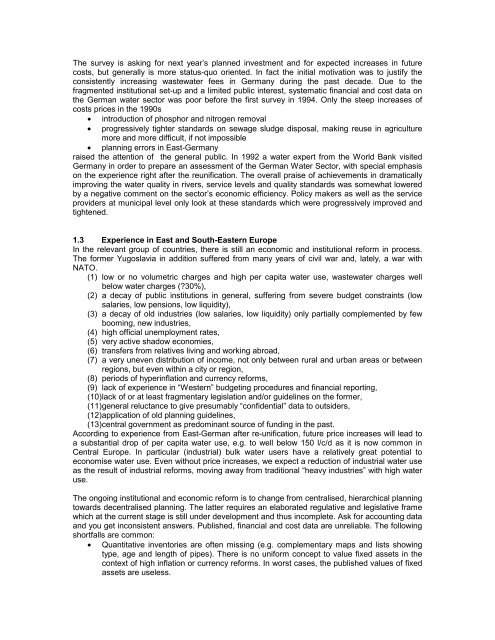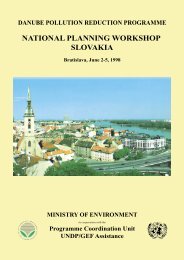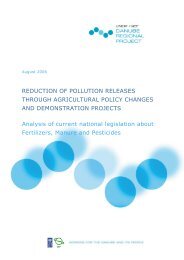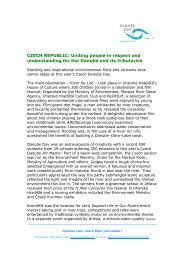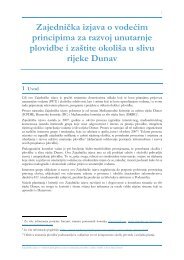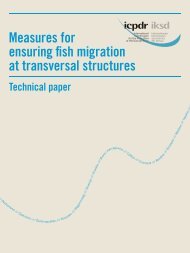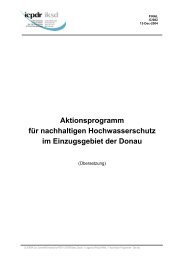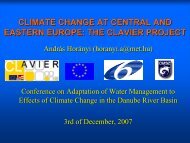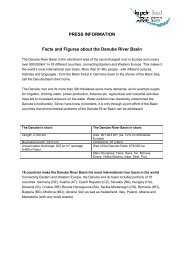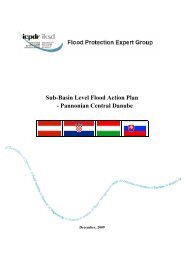Tariff Study Executive Summary - ICPDR
Tariff Study Executive Summary - ICPDR
Tariff Study Executive Summary - ICPDR
Create successful ePaper yourself
Turn your PDF publications into a flip-book with our unique Google optimized e-Paper software.
The survey is asking for next year’s planned investment and for expected increases in future<br />
costs, but generally is more status-quo oriented. In fact the initial motivation was to justify the<br />
consistently increasing wastewater fees in Germany during the past decade. Due to the<br />
fragmented institutional set-up and a limited public interest, systematic financial and cost data on<br />
the German water sector was poor before the first survey in 1994. Only the steep increases of<br />
costs prices in the 1990s<br />
• introduction of phosphor and nitrogen removal<br />
• progressively tighter standards on sewage sludge disposal, making reuse in agriculture<br />
more and more difficult, if not impossible<br />
• planning errors in East-Germany<br />
raised the attention of the general public. In 1992 a water expert from the World Bank visited<br />
Germany in order to prepare an assessment of the German Water Sector, with special emphasis<br />
on the experience right after the reunification. The overall praise of achievements in dramatically<br />
improving the water quality in rivers, service levels and quality standards was somewhat lowered<br />
by a negative comment on the sector’s economic efficiency. Policy makers as well as the service<br />
providers at municipal level only look at these standards which were progressively improved and<br />
tightened.<br />
1.3 Experience in East and South-Eastern Europe<br />
In the relevant group of countries, there is still an economic and institutional reform in process.<br />
The former Yugoslavia in addition suffered from many years of civil war and, lately, a war with<br />
NATO.<br />
(1) low or no volumetric charges and high per capita water use, wastewater charges well<br />
below water charges (?30%),<br />
(2) a decay of public institutions in general, suffering from severe budget constraints (low<br />
salaries, low pensions, low liquidity),<br />
(3) a decay of old industries (low salaries, low liquidity) only partially complemented by few<br />
booming, new industries,<br />
(4) high official unemployment rates,<br />
(5) very active shadow economies,<br />
(6) transfers from relatives living and working abroad,<br />
(7) a very uneven distribution of income, not only between rural and urban areas or between<br />
regions, but even within a city or region,<br />
(8) periods of hyperinflation and currency reforms,<br />
(9) lack of experience in “Western” budgeting procedures and financial reporting,<br />
(10) lack of or at least fragmentary legislation and/or guidelines on the former,<br />
(11) general reluctance to give presumably “confidential” data to outsiders,<br />
(12) application of old planning guidelines,<br />
(13) central government as predominant source of funding in the past.<br />
According to experience from East-German after re-unification, future price increases will lead to<br />
a substantial drop of per capita water use, e.g. to well below 150 l/c/d as it is now common in<br />
Central Europe. In particular (industrial) bulk water users have a relatively great potential to<br />
economise water use. Even without price increases, we expect a reduction of industrial water use<br />
as the result of industrial reforms, moving away from traditional “heavy industries” with high water<br />
use.<br />
The ongoing institutional and economic reform is to change from centralised, hierarchical planning<br />
towards decentralised planning. The latter requires an elaborated regulative and legislative frame<br />
which at the current stage is still under development and thus incomplete. Ask for accounting data<br />
and you get inconsistent answers. Published, financial and cost data are unreliable. The following<br />
shortfalls are common:<br />
• Quantitative inventories are often missing (e.g. complementary maps and lists showing<br />
type, age and length of pipes). There is no uniform concept to value fixed assets in the<br />
context of high inflation or currency reforms. In worst cases, the published values of fixed<br />
assets are useless.


